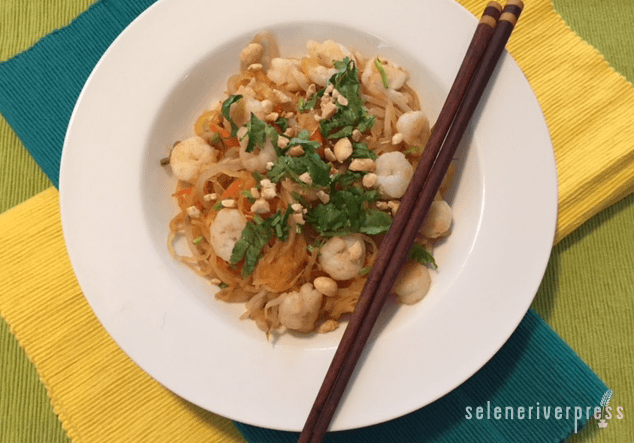Pad thai is one of my all-time favorite comfort foods. Perfectly balanced between salty, sour, sweet, and spicy, this classic Thai staple has many variations, but all will likely contain a few key ingredients: noodles, egg, and peanuts.
This dish is traditionally made with wide, flat rice noodles, and if not made properly it can turn out overcooked, sticky, and gummy. Recently, I decided to exchange spaghetti squash for the ever-inconsistent noodle. By swapping out the prime ingredient, the gummy noodle issue is no longer a problem, and the dish is both much lighter and more refreshing. I’m sure pad thai purists will reel when they hear of this atrocity, but I actually prefer it this way now.
The possible number of ways to customize pad thai are endless. Here I’ve used shrimp, but chicken is also a popular addition. A small (4 oz.) serving of shrimp provides almost 50 percent of our daily recommended protein intake and, surprisingly, over 100 percent of our recommended dose of tryptophan—the sleep-inducing amino acid most commonly associated with turkey. Shrimp is also a rich source of selenium and iodine, two critical micronutrients essential for proper thyroid function and glandular health. In addition, these minerals exhibit a superhero-like ability to fight cancer-causing radiation, something we should all take very seriously these days. To learn more about how necessary iodine is, read Iodine: Why You Need It, Why You Can’t Live Without It.
To boost the nutrition content of this dish, feel free to add more vegetables. However, one variation I wouldn’t suggest is skipping the fish sauce—even if you think you don’t like it. Fish sauce is essential to creating authentic Vietnamese and Thai dishes. It’s made by fermenting anchovies in salt for months at a time, and many people are put off by the very concept. But you’ll notice that the taste and odor transforms into a rich flavor that will give your final dish the taste dimension known as umami. This simply can’t be replicated with a substitute. My favorite fish sauce is Red Boat, which you can find at Whole Foods. It’s an amazing traditional fermented food, highly nutritious, and interesting to learn about.
Spaghetti Squash Shrimp Pad Thai
Prep time: 15 minutes
Cook time: 60 minutes
Serves 4
Ingredients
- 1 medium spaghetti squash (about 4 lbs.), cut in half and seeds removed
- Salt and pepper
- ¼ cup lime juice
- 3 tablespoons fish sauce (I prefer Red Boat brand)
- 2 tablespoons coconut palm or rapadura sugar
- 1 tablespoon chili sauce
- 2 eggs, beaten
- 1 tablespoon untoasted sesame or peanut oil
- 12 ozs. medium shrimp, peeled and deveined
- 2 shallots, finely diced
- 3 cloves garlic, minced
- 1 carrot, cut in fine matchsticks
- 2 cups bean sprouts
- 4 green onions, sliced
- ¼ cup toasted peanuts, roughly chopped
- ¼ cup cilantro, chopped
Instructions
- Preheat oven to 400°F. Season the inside of the spaghetti squash with salt and pepper. Bake, skin side up, until just tender, about 30 minutes. You want the strands to just pull away with a fork, still contain a little crunch, and not be mushy. Once cooked, shred strands with a fork. Set aside in a colander to drain any excess liquid off.
- Meanwhile, combine lime juice, fish sauce, sugar, and chili sauce in a small bowl. Set aside.
- Season the eggs with a pinch of salt. Heat a small amount of peanut or sesame oil in a wok and cook eggs until scrambled. Transfer to a bowl and set aside.
- Heat a little more oil in wok. Season shrimp with salt and pepper and add to wok. Cook until firm and opaque. Transfer to a bowl and set aside.
- Heat remaining oil in wok. Add shallots and garlic and stir-fry until translucent. Add carrots and sprouts and stir-fry one more minute.
- Add spaghetti squash, shrimp, egg, sauce, green onion, peanuts, and cilantro to wok. Stir-fry until everything is coated with sauce and combined. Adjust seasonings to taste.
AUTHOR’S NOTE
To choose your organically grown and fresh ingredients wisely, use the following criteria:
- chemical- and hormone-free meat
- wild-caught fish
- pasture-raised, organic eggs
- whole, unrefined grains
- virgin, unrefined, first-press organic oils
- whole-food, unrefined sweeteners
- pure, clean, spring water
- sea salt
- raw and/or cultured milk and cream products


